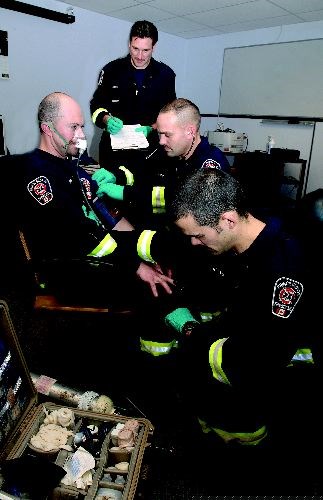The emergency call went out to attend to a hockey player who had collapsed on the bench at the Elksentre with a possible cardiac arrest.
Prince George Fire Rescue Services Cpt. Kevin Scobie arrived at the scene and recognized the 60-year-old man lying in the arena concourse.
Scobie immediately started by giving him oxygen and testing his blood saturation level while firefighter Cam Morris checked his blood pressure.
Noticing no pulse, the firemen began chest compressions and hooked up an airway as Scobie got out the automatic defibrillator and attached the sensors to the man.
Right away it told him the man's heart had stopped. Scobie applied the shock, and after no response, the machine told him to repeat the process. He then went back to chest compressions and the man regained consciousness, wondering what was going on. At that point, B.C. Ambulance Service paramedics arrived and took over his care.
Before the man could be brought to the emergency ward, two more hits of the defibrillator were required. He had to be brought back three more times in the hospital and was flown to Vancouver where it was determined three of his coronary arteries were blocked. He went on to recover from surgery and was with his wife when he ran into Scobie in June at a car show.
"He thanked me and his wife gave me a hug and that just made me feel fantastic," said Scobie. "There's no words to describe it. It's very humbling when something like that happens to you. I'm just glad we saved his life."
At the time, Scobie had just completed a four-hour refresher course in Emergency Medical Responder emergency patient care.
Prince George is the first fire department in the province to require its firefighters achieve the EMR ticket. Current PGFRS fire chief John Lane established the EMR program in 2006, a year after it first became available outside of the B.C. Ambulance Service (BCAS).
One of the benefits of EMR is firefighters are now allowed to administer gas for pain relief for their patients. They are also equipped to measure glucose levels to provide better care for diabetic patients.
Considering that in 2010, 63 per cent of all emergency calls the fire department received were to deal with medical issues, the push to institute EMR training two years ago is not going to waste.
In June, PGFRS firefighter and first aid instructor Jason McCarron was driving on the highway an hour south of Dease Lake when he came upon a motorcyclist from Ottawa who had collided with a bear.
The man was conscious but had a cracked skull, six broken ribs, a collapsed lung and a ruptured spleen, and McCarron recognized signs of him going into shock and just tried to keep him calm and monitor his vital signs.
Fortunately, a truck driver arrived who had a satellite phone and McCarron used it to call ambulance dispatch in Kamloops, which sent a helicopter to the scene.
After several surgeries the man made a full recovery and contacted McCarron to thank him.
"The biggest thing with our training is it gives you confidence to be able to deal with any medical situation, where even if you can do a little bit you can help," McCarron said. "I think anyone else in the department could have done the same thing."



